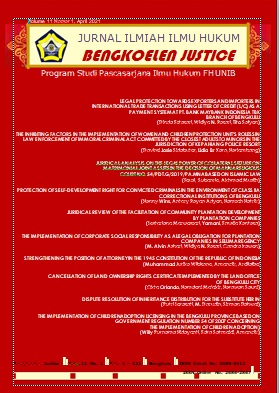Main Article Content
Abstract
The correctional institutions developing nowadays adopts a penal system that is more educating and fostering. Formerly, correctional institutions adhered to a prison system that was more of a punishment for crimes committed by the criminals. In general, fostering the prisoners aims to make prisoners to be fully human through the strengthening of faith (mental endurance) as well as to foster the prisoners to be able to integrate naturally in prison and in a wider life (community) after serving their convictions. This study on the protection of self-development right for convicted criminals in the environment of class IIA correctional institutions of Bengkulu was an empirical legal research that aimed to find out and to analyze the implementation of protection of self-development right for prisoners as well as to find out and to analyze the obstacles faced in implementing the protection of self-development right for prisoners in the environment of class IIA correctional institutions of Bengkulu. Data sources of this research were primary and secondary data. Data collection methods applied in this study were interviews and documentation. The data processing method used was descriptive qualitative. From the results of the study, it was revealed that: 1) the implementation of the fulfillment of juvenile prisoners’ right to obtain education at the class IIA correctional institutions of Bengkulu had not been fully fulfilled. To fulfill the educational process, there are Program Kejar (Kelompok Belajar/Study Group) of Package A (equivalent to elementary school), Package B (equivalent to junior high school), and Package C (equivalent to high school) as a series of processes for fulfilling the right for education for juvenile prisoners. But the program had not run optimally according to standards set by the government. Most of the juvenile prisoners make self-taught learning; 2) in the implementation of the education process in prisons, there were several factors that become obstacles in its implementation. These factors included the lack of partners to carry out the process of fulfilling the right for education, the facilities available in correctional institutions were inadequate, the limited teaching staffs provided by the local Education Department, lack of supervision on juvenile prisoners if they were pursuing education outside correctional institutions, as well as minimal budget allocations for educational purpose in correctional institutions.
Keywords
Article Details
References
- A. Gunawan Setiardja. 1993. Hak-Hak Asasi Manusia Berdasarkan Ideologi Pancasila. Yogyakarta: Kanisius.
- Adi Sudjatno, Negara tanpa Penjara: Sebuah Renungan, Montas Ad, Jakarta, 2002
- Adi Sudjatno, Sistem Pemasyarakatan Indonesia Membangun Manusia Mandiri, Departemen Hukum dan Hak Asasi Manusia (HAM) Republik Indonesia, Direktorat Jenderal Pemasyarakatan, Jakarta, 2004.
- Andi Hamzah, Sistem Pidana dan Pemidanaan di Indonesia, Pradnya Paramitha, Jakarta, 1993.
- Bambang Poernomo. 1986. Pelaksanaan pidana penjara dengan sistem pemasyarakatan. Yogyakarta: Liberty Yogyakarta.
- C. I. Harsono Hs, Sistem Baru Pembinaan Narapidana, Penerbit Djambatan, Jakarta, 1995
- Darwan Print. 2003. Hukum Anak Indonesia. Bandung:PT. Citra Aditya Bakti.
- Didin Sudirman,Reposisi dan Revitalisasi Pemsayarakatan dalam Sistem Peradilan Pidana di Indonesia, Departemen Hukum dan Hak Asasi Manusia (HAM) Republik Indonesia, Pusat Pengkajian dan Pengembangan Kebijakan, Jakarta, 2007
- Dwidja Priyatno, Sistem Pelaksanaan Pidana Penjara di Indonesia, Cetakan Ketiga, Refika Aditama, Bandung, 2013.
- Dwidja Priyatno. 2006. Sistem Pelaksanaan Pidana Penjara Di Indonesia. Bandung: PT. Refika Aditama. Gasti Ratnawati. Pola Pembinaan NAPI Anak sebagai Salah Satu Upaya Pemenuhan Kebutuhan Pendidikan di Lembaga Pemasyarakatan Anak. Malang. PDF.
- Hesly E. Marentek, Pembinaan terhadap Warga Binaan dalam Lembaga Pemasyarakatan Ditinjau dari Perspektif Peraturan Perundang-undangan yang Berlaku, Jurnal Lex Crimen, Vol. IV, No. 8, Oktober 2015.
- I Gede Ardian Paramandika, Pembinaan terhadap Narapidana di Lembaga Pemasyarakatan Klas IIA Denpasar. [Jurnal] Program Magister Ilmu Hukum, Fakultas Hukum, Universitas Udayana, Denpasar, 2012: 1-6.
- Maulana Hassan Wadong. 2000. Pengantar Advokasi dan Perlindungan Anak. Jakarta: PT. Gramedia.
- Naney Nelson Knupfer & Hilary McLellan, Descriptive research methodologies, Kanzas State University Press, Manhattan, USA, 1990,
- Peter Mahmud Marzuki, Penelitian Hukum, Edisi Revisi, Cetakan Keenam, Kencana: Prenada Media Group, Jakarta, 2010
References
A. Gunawan Setiardja. 1993. Hak-Hak Asasi Manusia Berdasarkan Ideologi Pancasila. Yogyakarta: Kanisius.
Adi Sudjatno, Negara tanpa Penjara: Sebuah Renungan, Montas Ad, Jakarta, 2002
Adi Sudjatno, Sistem Pemasyarakatan Indonesia Membangun Manusia Mandiri, Departemen Hukum dan Hak Asasi Manusia (HAM) Republik Indonesia, Direktorat Jenderal Pemasyarakatan, Jakarta, 2004.
Andi Hamzah, Sistem Pidana dan Pemidanaan di Indonesia, Pradnya Paramitha, Jakarta, 1993.
Bambang Poernomo. 1986. Pelaksanaan pidana penjara dengan sistem pemasyarakatan. Yogyakarta: Liberty Yogyakarta.
C. I. Harsono Hs, Sistem Baru Pembinaan Narapidana, Penerbit Djambatan, Jakarta, 1995
Darwan Print. 2003. Hukum Anak Indonesia. Bandung:PT. Citra Aditya Bakti.
Didin Sudirman,Reposisi dan Revitalisasi Pemsayarakatan dalam Sistem Peradilan Pidana di Indonesia, Departemen Hukum dan Hak Asasi Manusia (HAM) Republik Indonesia, Pusat Pengkajian dan Pengembangan Kebijakan, Jakarta, 2007
Dwidja Priyatno, Sistem Pelaksanaan Pidana Penjara di Indonesia, Cetakan Ketiga, Refika Aditama, Bandung, 2013.
Dwidja Priyatno. 2006. Sistem Pelaksanaan Pidana Penjara Di Indonesia. Bandung: PT. Refika Aditama. Gasti Ratnawati. Pola Pembinaan NAPI Anak sebagai Salah Satu Upaya Pemenuhan Kebutuhan Pendidikan di Lembaga Pemasyarakatan Anak. Malang. PDF.
Hesly E. Marentek, Pembinaan terhadap Warga Binaan dalam Lembaga Pemasyarakatan Ditinjau dari Perspektif Peraturan Perundang-undangan yang Berlaku, Jurnal Lex Crimen, Vol. IV, No. 8, Oktober 2015.
I Gede Ardian Paramandika, Pembinaan terhadap Narapidana di Lembaga Pemasyarakatan Klas IIA Denpasar. [Jurnal] Program Magister Ilmu Hukum, Fakultas Hukum, Universitas Udayana, Denpasar, 2012: 1-6.
Maulana Hassan Wadong. 2000. Pengantar Advokasi dan Perlindungan Anak. Jakarta: PT. Gramedia.
Naney Nelson Knupfer & Hilary McLellan, Descriptive research methodologies, Kanzas State University Press, Manhattan, USA, 1990,
Peter Mahmud Marzuki, Penelitian Hukum, Edisi Revisi, Cetakan Keenam, Kencana: Prenada Media Group, Jakarta, 2010

